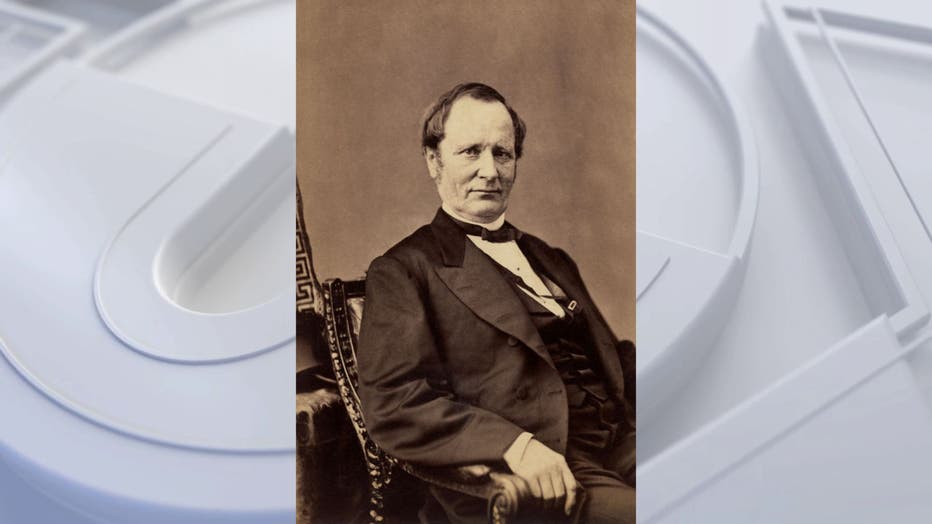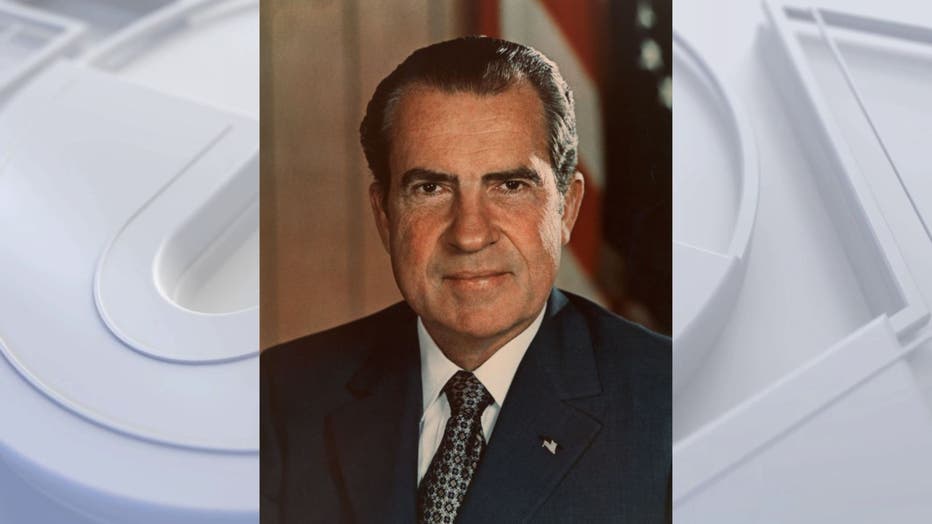How many Vice Presidents have run for President? How many won?
LOS ANGELES - We are less than three months away from the 2024 Presidential election, and after the Democratic National Convention ended this week in Chicago, the two major candidates have been cemented. Former President Donald Trump will run for the third straight time as the Republican Party’s nominee, while Vice President Kamala Harris accepted the Democratic Party’s nomination just days ago.
Harris has already made history as the first female Vice President and could potentially make even more history if she were to win the election, becoming the first female President of the United States of America.
But she also joins a long list of Vice Presidents who have vied for the top job — a list which includes her current boss, Joe Biden. But how many Vice Presidents have run for President?
Here’s a look, chronologically:

(From top to bottom, left to right) Vice President Kamala Harris, President Joe Biden, former Vice President Al Gore, former President George H.W. Bush, former President Richard Nixon, former President Harry Truman, former President Gerald Ford and f
The first thing to get out of the way is that before 1804, presidential elections in the U.S. worked a little bit differently. Back then, candidates didn’t have running mates, and voters didn’t vote for a presidential ticket. Instead, the top vote-getter won the presidency, and the runner-up was awarded the vice presidency. Therefore, prior to 1804, and the adoption of the Twelfth Amendment to the Constitution, there were several Vice Presidents who ran for president, who only got the vice presidency because they lost the job they really wanted. That list includes:
- John Adams, who served as George Washington’s Vice President from 1789-1797
- Thomas Jefferson, who served as John Adams’ Vice President from 1797-1801
- Aaron Burr, who served as Thomas Jefferson’s Vice President from 1801-1805
George Clinton

An engraving from a portrait of George Clinton, served as New York governor for 21 years and was the fourth Vice President of the United States, New York, 1826. From the New York Public Library. (Photo by Smith Collection/Gado/Getty Images).
George Clinton served as Vice President for two Presidents — Thomas Jefferson and James Madison — in consecutive terms from 1805 to 1812. But he also unsuccessfully ran for President four times, in 1789, 1792, 1796 and 1808, never finishing higher than third in the electoral vote. And before you ask, no, George Clinton is not related to Bill Clinton.
Millard Fillmore

Portrait of the 13th U.S. President Millard Fillmore. (1800-1874) (Courtesy of the National Archives/Newsmakers)
Millard Fillmore was the 13th President of the United States, despite losing the only time he actually ran for President. Fillmore served as Vice President under Zachary Taylor from 1849 until 1850, when Taylor died of cholera. Taylor was the second President to die while in office. Fillmore served as President until 1853. He ran again in the 1856 election, coming in a distant third to James Buchanan and John C. Frémont.
John C. Breckinridge

Breckinridge, John C. 1821-1875. Running mate of James Buchanan, vice president, 1856-1860.
John C. Breckinridge was the 14th Vice President of the United States, serving under James Buchanan from 1857-1861. As Kamala Harris is currently doing, Breckinridge spent the end of his VP term running for President. He ran against Abraham Lincoln, winning 72 electoral votes to Lincoln’s 180. Breckinridge then went on to be a Confederate officer during the Civil War.
Thomas A. Hendricks

Thomas A. Hendricks (1819-1885), American Politician and Lawyer, Governor of Indiana 1873-77, Vice President of the U.S. 1885-85, half-length Portrait, Mathew B. Brady, 1876. (Photo by: Circa Images/GHI/Universal History Archive/Universal Images Grou
Thomas Hendricks tried very hard to make it to the White House, and eventually did. But unfortunately, he didn’t last long. After serving as an Indiana Congressman and later Governor of the state, Hendricks ran for President in 1872. He lost that election to Ulysses S. Grant, but he didn’t give up. Four years later, Hendricks was on the Democratic ticket for the 1876 election alongside Samuel Tilden. Tilden (and consequently, Hendricks) narrowly lost that election to Rutherford B. Hayes by just one electoral vote.
Hendricks then ran again in 1884, alongside Grover Cleveland, and was finally elected Vice President. Nine months into his tenure, however, Hendricks died in office.
Theodore Roosevelt

Theodore Roosevelt (1858-1919), the 26th President of the United States, (1901-1909).
When William McKinley was assassinated in Buffalo, New York, on Sept. 14, 1901, Theodore Roosevelt ascended to the presidency. From there, "Teddy" Roosevelt would go on to be one of the most famous presidents in American history. Roosevelt ran for reelection at the end of his term, winning nearly 60% of the vote. Roosevelt would go on to run unsuccessfully for President again in 1912 and 1916.
Calvin Coolidge

(Original Caption) Calvin Coolidge is seen here, (1872-1933), the 30th President of the United States. This is a head and shoulders photograph.
Calvin Coolidge became the 30th President of the United States after another death in office, this time the death of Warren G. Harding in 1923. Coolidge completed that term, then ran for reelection in 1924, winning the popular vote by more than 7 million. Since this was all before the presidency established term limits, Coolidge could have run again in 1928, but decided not to.
Henry A. Wallace

Henry A Wallace, American politician, 1930s. (Photo by Historica Graphica Collection/Heritage Images/Getty Images)
Henry Wallace was the second of three Vice Presidents to serve under Franklin D. Roosevelt. Before that, he was Secretary of Agriculture starting during FDR’s first term. Wallace unsuccessfully ran for President in 1944. Wallace earned just more than 1.1 million votes. After that, he went to serve as Harry Truman’s Secretary of Commerce.
Harry S. Truman

(Original Caption) 1949: Official portrait of Harry S. Truman (1884-1972), 33rd President of the United States.
Harry Truman took over the presidency after Franklin Roosevelt’s death in 1945, less than a month before Germany surrendered, ending World War II in Europe. Truman would go on to drop atomic bombs on Hiroshima and Nagasaki, leading to Japan’s surrender and the end of the war. Truman ran for reelection in 1948 and won in a now-infamously close election.

President Harry Truman holds up a copy of the Chicago Daily Tribune declaring his defeat to Thomas Dewey in the presidential election, St Louis, MIssouri, November 1948. (Photo by Underwood Archives/Getty Images)
Richard Nixon

Circa 1968: Headshot portrait of 37th American president Richard M. Nixon (1913-1994), wearing a U.S. flag lapel pin, smiling in front of a U.S. flag. Nixon's presidency lasted from 1968 until 1974. (Photo by White House Photos/Getty Images)
Long before Watergate, Richard Nixon served as Vice President under Dwight Eisenhower for two terms. At the end of his second vice presidential term, Nixon ran for President and lost against John F. Kennedy in the 1960 election. After another failed campaign, this time for Governor of California, Nixon was elected President in 1968 and reelected in 1972 by one of the largest margins in American history. Less than two years later, Nixon would resign the presidency for his involvement in the Watergate scandal and cover-up, paving the way for VP Gerald Ford, who makes an appearance later on down this list. Nixon remains the only President in U.S. history to resign the position.
Lyndon B. Johnson

LYNDON B. JOHNSON 1964 UPI COLOR SLIDE
Vice President Lyndon B. Johnson took the oath of office onboard Air Force One after the assassination of President John F. Kennedy in 1963, becoming the 36th President. Johnson would go on to win reelection in 1964 by a huge margin. As his popularity dwindled during his presidency due to the country’s involvement in the Vietnam War, Johnson did not seek reelection in 1968.
Hubert Humphrey

(Original Caption) Washington, D.C.: Sen. Hubert Humphrey is photographed in the Capitol.
While LBJ didn’t seek reelection in 1968, his Vice President Hubert Humphrey did. Despite a close popular vote, Humphrey lost to Richard Nixon by a wide margin in the electoral vote. After the loss, Humphrey was elected to two terms in the U.S. Senate, representing the state of Minnesota, before dying during his second term in 1978.
Gerald Ford

The first official presidential portrait of Gerald R. Ford, made on the day he assumed office upon Richard M. Nixon's resignation. (Photo by © CORBIS/Corbis via Getty Images)
While Gerald Ford was the first (and only) person to take over from a resigning U.S. President, Ford’s path to the vice presidency was also marked by a first. Ford was the first Vice President to be appointed under the 25th Amendment to the U.S. Constitution. Prior to that, when the VP spot became empty, whether because the VP had ascended to the presidency, or in this case because of the resignation of Spiro Agnew, the spot stayed empty.
Ford took the oath of office for VP in 1973, serving under Richard Nixon. A year later, he took over for Nixon and saw the term out. Ford would try and run for reelection in 1976, but ended up losing out to Jimmy Carter.
Walter Mondale

Walter Frederick Mondale (born January 5, 1928) is an American Democratic Party politician who served as the 42nd Vice President of the United States (1977-81) under President Jimmy Carter. (Photo by: Universal History Archive/ Universal Images Group
Walter Mondale served as Vice President under Jimmy Carter from 1977-1981. Carter and Mondale ran together again in 1980, losing to Ronald Reagan. But it wasn’t Mondale’s last bid for the White House. He challenged Reagan again in 1984, this time as a presidential candidate, and lost by an even bigger margin.
George H.W. Bush

circa 1989: Forty-First president of the United States George Bush (1989 - 1993). (Photo by Hulton Archive/Getty Images)
After serving back-to-back terms as Ronald Reagan’s VP, George H.W. Bush transitioned right into the presidency after the 1988 election. However, he failed to win reelection in 1992, losing to Bill Clinton.
Al Gore

Headshot portrait of U.S. vice president Al Gore posing with the American flag in the background, circa 1995. (Photo by CNP/Getty Images)
Al Gore served as Bill Clinton’s Vice President from 1993 to 2001. In 2000, Gore won the Democratic Party’s nomination, running alongside Joe Lieberman. Gore won the popular vote against Republican Candidate George W. Bush, but ended up losing the electoral vote after a contentious Florida election that was ultimately decided by the U.S. Supreme Court.
Joe Biden
The current President, Joe Biden, attempted to run for President in the 2008 election, before eventually becoming Barack Obama’s running mate. Before serving as Vice President from 2009-2017, Biden was a Democratic Senator from Delaware for nearly 40 years. Biden, of course, won the 2020 presidential election against Donald Trump, and was considering seeking reelection until announcing he would step away from the race on July 21.
Kamala Harris
The newest Democratic candidate, Kamala Harris, will be the 17th Vice President to seek election to the presidency. Harris served as California's Attorney General from 2011-2016 before being elected to the U.S. Senate, where she served until leaving to become Vice President. She briefly ran for President in 2020, before eventually becoming Joe Biden's running mate. On Thursday, Harris accepted the Democratic Party's nomination for President in the upcoming election, and is running alongside Minnesota Gov. Tim Walz.

